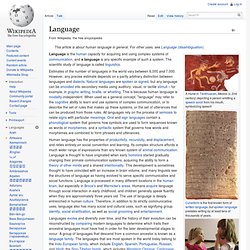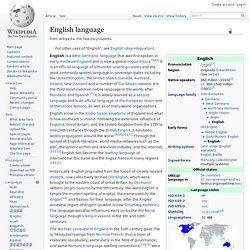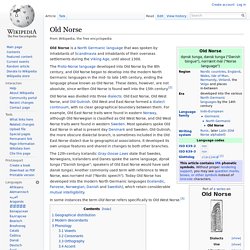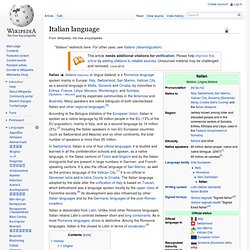

Language. A mural in Teotihuacan, Mexico (c. 2nd century) depicting a person emitting a speech scroll from his mouth, symbolizing speech Language is the human capacity for acquiring and using complex systems of communication, and a language is any specific example of such a system.

The scientific study of language is called linguistics. Languages evolve and diversify over time, and the history of their evolution can be reconstructed by comparing modern languages to determine which traits their ancestral languages must have had in order for the later developmental stages to occur. A group of languages that descend from a common ancestor is known as a language family.
Definitions[edit] As an object of linguistic study, "language" has two primary meanings: an abstract concept, and a specific linguistic system, e.g. Mental faculty, organ or instinct[edit] Formal symbolic system[edit] Tool for communication[edit] Goidelic languages. The Goidelic or Gaelic languages (Irish: teangacha Gaelacha, Scottish Gaelic: cànanan Goidhealach, Manx: çhengaghyn Gaelgagh) are one of the two branches of the Insular Celtic languages, the other consisting of the Brittonic languages.[2] Goidelic languages historically formed a dialect continuum stretching from Ireland through the Isle of Man to Scotland.

There are three modern Goidelic languages: Irish (Gaeilge), Scottish Gaelic (Gàidhlig) and Manx (Gaelg), the last of which died out in the 20th century, but has since been revived to some degree.[3] The Goidelic languages are part of the Q-Celtic branch of the Celtic languages. Nomenclature[edit] The names used in the languages themselves (Gaeilge/Gaolainn/Gaelic in Irish, Gaelg/Gailck in Manx, and Gàidhlig in Scottish Gaelic) are derived from Old Irish Goídelc, which comes from Old Welsh Guoidel meaning "pirate, raider".[4][5] English language. English is a West Germanic language that was first spoken in early medieval England and is now a global lingua franca.[5][6] It is an official language of almost 60 sovereign states and the most commonly spoken language in sovereign states including the United Kingdom, the United States, Canada, Australia, Ireland, New Zealand and a number of Caribbean nations.

It is the third-most-common native language in the world, after Mandarin and Spanish.[7] It is widely learned as a second language and is an official language of the European Union and of the United Nations, as well as of many world organisations. English arose in the Anglo-Saxon kingdoms of England and what is now southeast Scotland. The Norman conquest of England in the 11th century gave rise to heavy borrowings from Norman French: thus a layer of elaborate vocabulary, particularly in the field of governance, and some Romance-language spelling conventions[17][18] were added to what had by then become Middle English.
Etymology. Old Norse. Old Norse is a North Germanic language that was spoken by inhabitants of Scandinavia and inhabitants of their overseas settlements during the Viking Age, until about 1300.

The Proto-Norse language developed into Old Norse by the 8th century, and Old Norse began to develop into the modern North Germanic languages in the mid- to late 14th century, ending the language phase known as Old Norse. These dates, however, are not absolute, since written Old Norse is found well into the 15th century.[2] Old Norse was divided into three dialects: Old East Norse, Old West Norse, and Old Gutnish. Old West and East Norse formed a dialect continuum, with no clear geographical boundary between them. For example, Old East Norse traits were found in eastern Norway, although Old Norwegian is classified as Old West Norse, and Old West Norse traits were found in western Sweden. In some instances the term Old Norse refers specifically to Old West Norse.[3] Geographical distribution[edit] Italian language. Italian ( italiano or lingua italiana) is a Romance language spoken mainly in Europe: Italy, Switzerland, San Marino, Vatican City, as a second language in Malta, Slovenia and Croatia, by minorities in Eritrea, France, Libya, Monaco, Montenegro, and Somalia,[5][dubious ] and by expatriate communities in the Americas and Australia.

Many speakers are native bilinguals of both standardised Italian and other regional languages.[6] According to the Bologna statistics of the European Union, Italian is spoken as a native language by 59 million people in the EU (13% of the EU population), mainly in Italy, and as a second language by 14 million (3%).[2] Including the Italian speakers in non-EU European countries (such as Switzerland and Albania) and on other continents, the total number of speakers is more than 85 million. History Origins Renaissance Starting with the Renaissance Italian became the language used in the courts of every state in the peninsula. Modern era Contemporary times Classification.
French language. French (le français [lə fʁ̥ɒ̃sɛ] ( ) or la langue française [la lɑ̃ɡ fʁɑ̃sɛz]) is a Romance language spoken as a first language in France, the Romandy region in Switzerland, Wallonia and Brussels in Belgium, Monaco, the provinces of Quebec, Ontario and New Brunswick (Acadia region) in Canada also in Haiti, the Acadiana region of the U.S. state of Louisiana, the northern parts of the U.S. states of Maine, New Hampshire and Vermont in the New England region, and by various communities elsewhere.

Other speakers of French, who often speak it as a second language,[3] are distributed throughout many parts of the world, the largest numbers of whom reside in Francophone Africa.[4] In Africa, French is most commonly spoken in Gabon (where 80% report fluency),[4] Mauritius (78%), Algeria (75%), Senegal and Côte d'Ivoire (70%). French is estimated as having 110 million[3] native speakers and 190 million more second language speakers.[5] Geographic distribution[edit] Europe[edit]